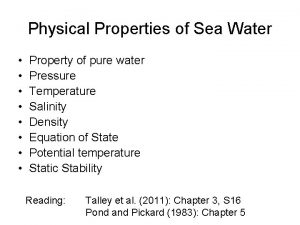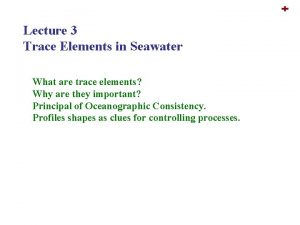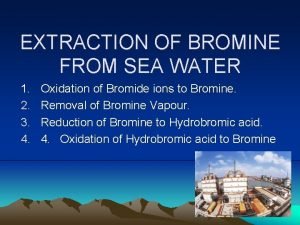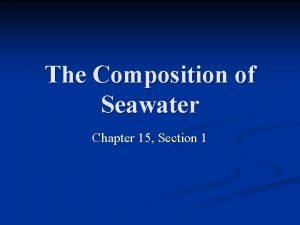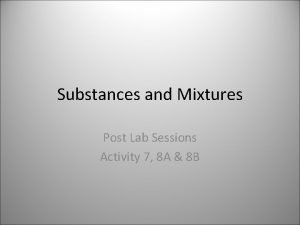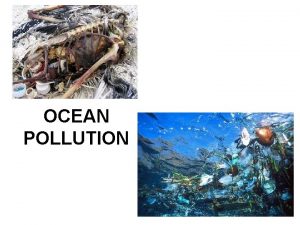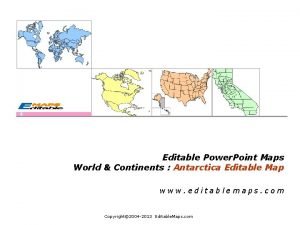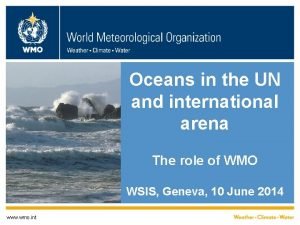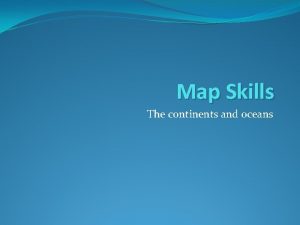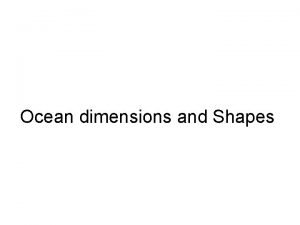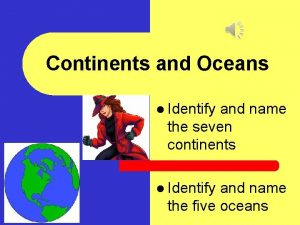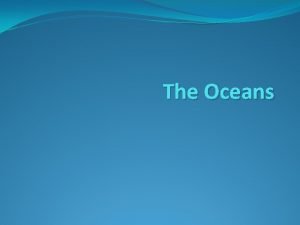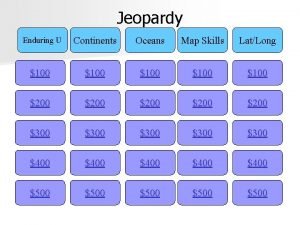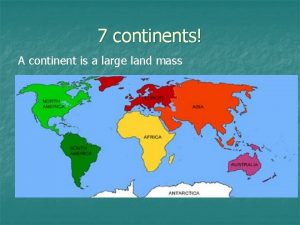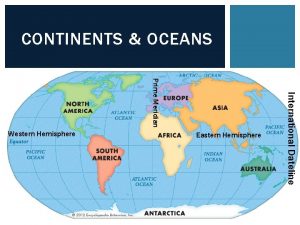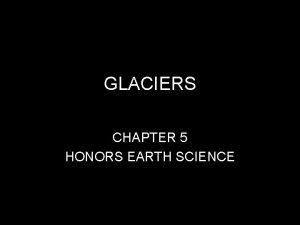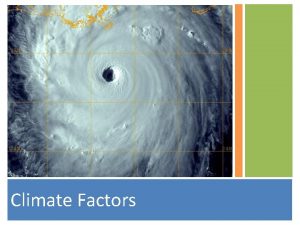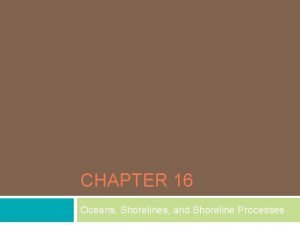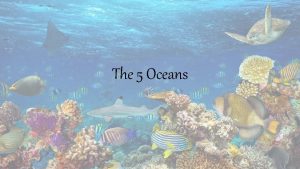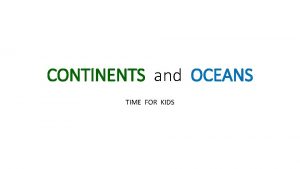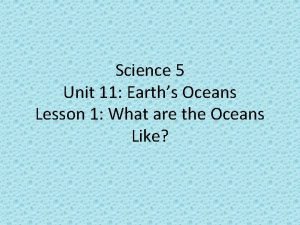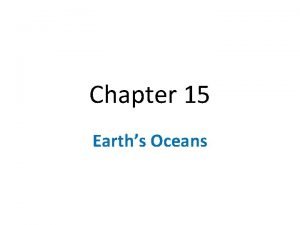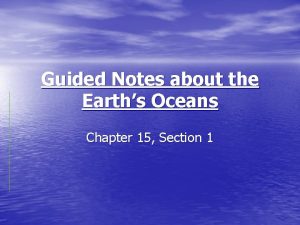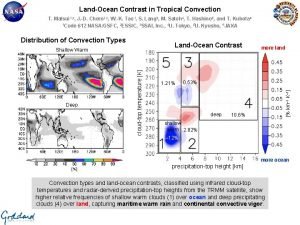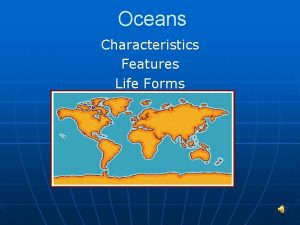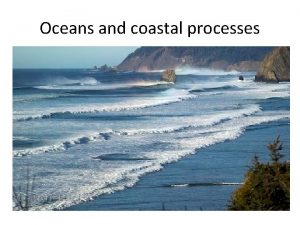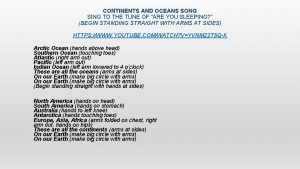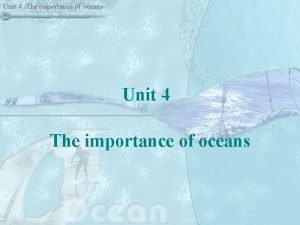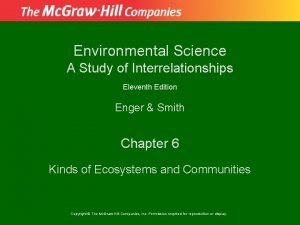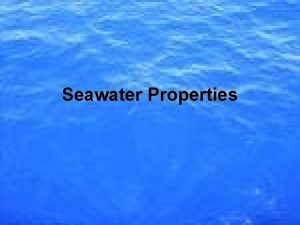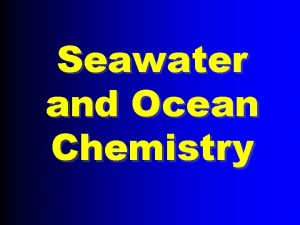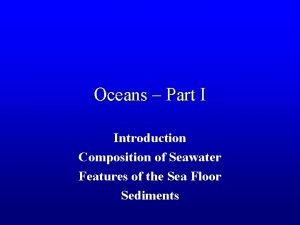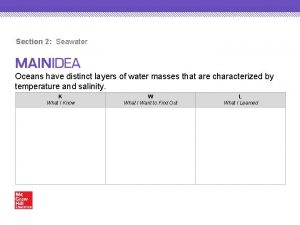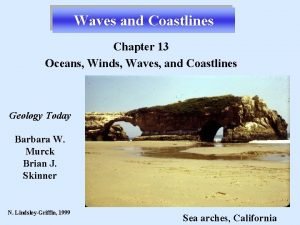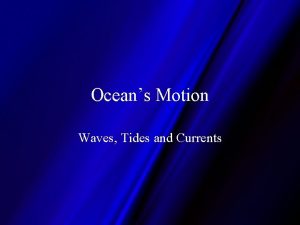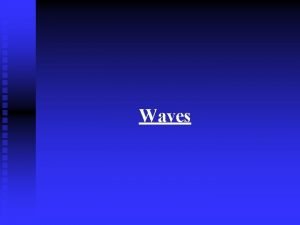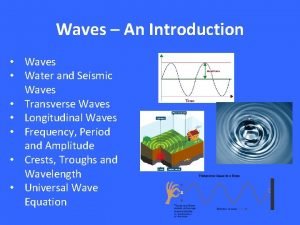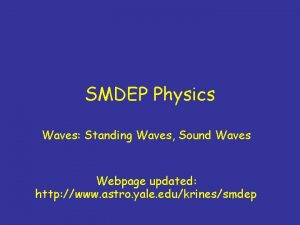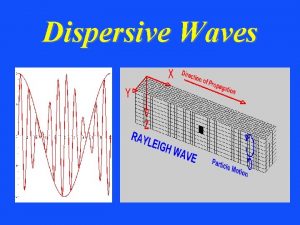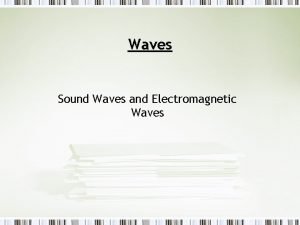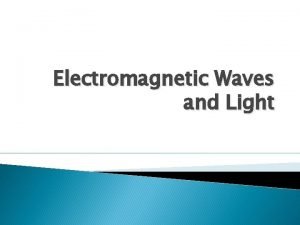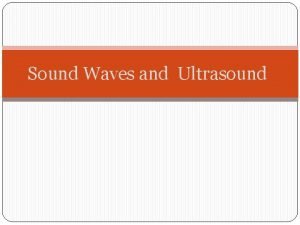The Oceans Waves Steve TerrillStock Market I SEAWATER


























































- Slides: 58

The Oceans & Waves Steve Terrill/Stock Market

I. SEAWATER • Covers 71% of Earth’s surface • Nature of seawater – 35 o/oo dissolved salts (30 -38) – Varies from place to place • Origin of seawater – Volcanoes? – Comets? – Excess H+ & O-?

II. CURRENTS • Ocean water moves constantly sideways, up, down because it is: – Heated unevenly – Evaporated unevenly – Blown by wind – Affected by Earth’s rotation – Pulled by sun & moon • Currents are the flow of water between areas of different surface levels or different densities

Surface ocean currents are run by climate & rotation

Density Currents • Function of – Temperature (polar regions) – Salinity (Mediterranean Sea) – Suspended materials (turbidities- flow of muddy water down a slope) • Deep ocean currents move by – density & thermal differences – the Coriolis effect • NADW, AABW

Average surface salinity of the oceans

August sea-surface temperatures

Circulation of the Atlantic Ocean

CONVEYOR BELT

Turbidity Currents


III. Tides Twice daily rise and fall of the sea caused by the gravitational attraction between • earth and moon (lunar tides) • earth and sun (solar tides) Function of distance between and mass of the Earth, Moon and Sun


Interaction between lunar and solar tides during the lunar month causes: • Neap tides: when two tidal components are out-of-phase, hence lower than usual, and • Spring tides: when two tidal components are in-phase, hence higher than usual.

The highest and lowest tides occur due to the interaction of earth, moon, and sun

The effect of tides on a tidal inlet.

Mont-Saint-Michel France Exposed tidal flats Thierry Prat/Sygma

Terrace Exposed at Low Tide James Valentine

IV. WAVES • Waves are described by – Wave length(L): distance between crests – Wave height (H) : vertical distance between crest and trough – Wave period (T): time for successive waves to pass a fixed point – Wave velocity (V) of waves (V = L/T) • 2 kinds of waves – Deep water waves – Shallow water waves

Wind-generated Orbital Waves

Most waves are generated in the open ocean & • height depends on: – Wind velocity – Wind duration – Distance over which wind blows called the FETCH, usually a big storm.

Shallow water waves • At water depth of L/2, wave feels bottom. Then: • Wave height Increases as • Wave length decreases. • Velocity decreases because wave is dragging on bottom. • Period doesn’t change • When wave reaches 1. 3 H -> BREAKER


Wave refraction • Bending of wave crests as they approach the beach at an angle • Caused by the change in velocity of waves as a function of water depth • Only a small part of each wave feels bottom at a time so only a small part of wave slows.

Wave Refraction

Waves Bending as they Approach the Beach John S. Shelton

Sediment transport near shore, parallel to the beach • Longshore drift: drift sediment carried by swash and backwash along the beach • Longshore currents: currents parallel to the beach within the surf zone

Longshore Drift

V. COASTS • BEACHES • EROSIONAL COASTS -uplift • DEPOSITIONAL COASTS - sinking • CHANGES IN SEA LEVEL-relative

Refraction at Headlands and Bays

Carving a coast • Waves & currents act the same as streams except work in both directions • Erode - in high energy areas by – Abrasion – Solution – Wave pressure • Deposit -in low energy areas

Sandy Beach, North Carolina Barrier Island Peter Kresan

Boulder Beach, Massachusetts Raymond Siever

Major parts of beaches • Offshore: Offshore from where the waves begin to feel bottom to the surf zone • Foreshore: Foreshore includes the surf zone, tidal flats, and swash zone • Backshore: Backshore from beyond the swash zone to the highest level of the beach

Major Parts of a Beach

Sand Budget of a Beach

Factors determining rates of erosion or deposition • • • Uplift Subsidence Rock type Sea-level changes Storm wave heights Tidal range

Erosional Coasts • Region of up-lift - JOB IS TO STRAIGHTEN SHORELINE • Prominent cliffs & headlands • Narrow inlets, irregular bays & beaches • Undercut cliffs – Sea stacks – Wave-cut terraces • Falling sea level

Sea Stacks Kevin Schafer

Wave-cut Terrace Exposed at Low Tide John S. Shelton

Uplifted Coastal Terrace John S. Shelton

Depositional Coasts • Sinking coasts • Long, wide beaches – Bars – Spits – Barrier islands – Tidal flats & shallow lagoons • Low-lying, sedimentary coastal plains • Rising sea level - estuary


Southern Tip of Cape Cod Steve Durwell/The Image Bank

Partially Developed Barrier Island Mainland Florida Lagoon Barrier Island Gulf of Mexico Richard A. Davis, Jr

Effects of rising sea level: Eastern North America and Europe

VI. Preventing beach erosion • Structural approaches (e. g. , groins): typically cause increased erosion down current of structure • Non-structural approaches (e. g. , beach nourishment, land use planning): expensive, but don’t cause erosion in new areas

Erosion Deposition Phillip Plissin/Explorer Groin: Built to Prevent Updrift Erosion Causes Downdrift Erosion

Interrupting longshore currents

Beach Nourishment, New Jersey U. S. Corps of Engineers, New York District

From volcanic island to an atoll

Atoll Fringing Reef Guido Alberto Rosi/The Image Bank Some of the Maldive Islands in the Pacific

IX. Types of marine sediment • Terrigenous material eroded from the continents • Biochemically precipitated shells of marine organisms • Abiotic chemical precipitates • Extraterrestrial material

Oceanic Ooze Scripps Institute of Oceanography, University of California, San Diego

The END

Carbonate Compensation Depth below which carbonate material dissolves in seawater

Origin of the lunar tides

Changes in Waves as they Approach the Beach
 Ronald wayne biography
Ronald wayne biography Market leader market challenger market follower
Market leader market challenger market follower International segmentation
International segmentation Difference between matter waves and electromagnetic waves
Difference between matter waves and electromagnetic waves High and low frequency waves
High and low frequency waves Compare and contrast p waves and s waves using venn diagram
Compare and contrast p waves and s waves using venn diagram Seismic waves are mechanical waves
Seismic waves are mechanical waves Characteristics of a longitudinal wave
Characteristics of a longitudinal wave Mechanical vs electromagnetic
Mechanical vs electromagnetic Sound is a transverse wave true or false
Sound is a transverse wave true or false Mechanical waves vs electromagnetic waves venn diagram
Mechanical waves vs electromagnetic waves venn diagram Whats a reflected sound wave
Whats a reflected sound wave Similarities of mechanical and electromagnetic waves
Similarities of mechanical and electromagnetic waves Mechanical waves characteristics
Mechanical waves characteristics What are constructive waves
What are constructive waves Short wave vs long wave radiation
Short wave vs long wave radiation Seismic waves
Seismic waves What is a rainbow
What is a rainbow Physical properties of sea water
Physical properties of sea water Colligative properties of seawater
Colligative properties of seawater Trace elements in seawater
Trace elements in seawater Bromine from sea water
Bromine from sea water Composition seawater
Composition seawater Boiling point of seawater
Boiling point of seawater Size of great pacific garbage patch
Size of great pacific garbage patch Antarctica outline map
Antarctica outline map Oceans arena
Oceans arena Continents and oceans
Continents and oceans Shape of oceans
Shape of oceans 7 continents and 4 oceans
7 continents and 4 oceans Earth covered in water
Earth covered in water Human impact on oceans
Human impact on oceans 5 branches of oceanography
5 branches of oceanography Continents and oceans jeopardy
Continents and oceans jeopardy What are the 7 continents and 5 oceans
What are the 7 continents and 5 oceans Eastern hemisphere oceans
Eastern hemisphere oceans Moraine
Moraine Water oceans
Water oceans Tombolo
Tombolo Label the world's 5 oceans
Label the world's 5 oceans All oceans are connected
All oceans are connected Oceans 7/11
Oceans 7/11 The four oceans
The four oceans Continents and oceans jeopardy
Continents and oceans jeopardy What's the 5 oceans
What's the 5 oceans World map continents and oceans
World map continents and oceans Biggest to smallest oceans
Biggest to smallest oceans Makemegenius
Makemegenius Oceans map
Oceans map In addition to moving horizontally ocean water moves
In addition to moving horizontally ocean water moves Ocean the part day after day
Ocean the part day after day Chapter 15 earth's oceans study guide answer key
Chapter 15 earth's oceans study guide answer key Oceans 12 matsui
Oceans 12 matsui What are the five themes of geography
What are the five themes of geography Characteristics of oceans
Characteristics of oceans Where does deposition occur
Where does deposition occur Continents and oceans
Continents and oceans Importance of oceans
Importance of oceans Human impact on oceans
Human impact on oceans


















